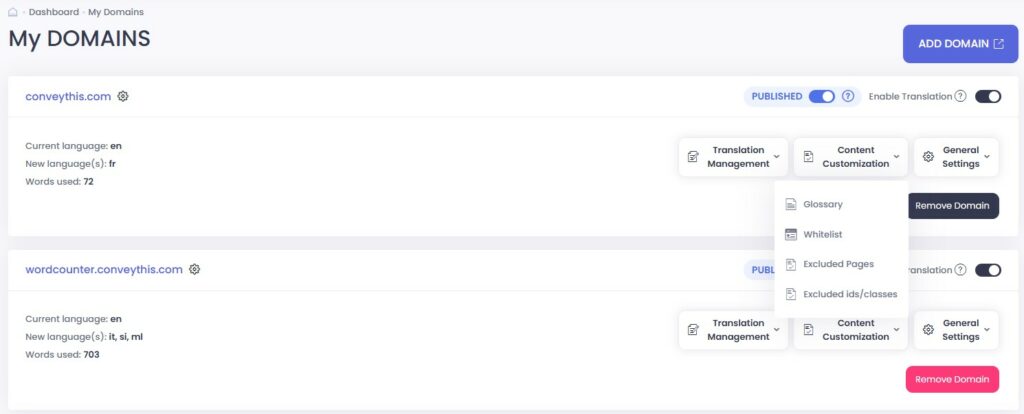How Can We Help?
Exclude Pages and Divs from Translation with ConveyThis
Glossary, Whitelist, Excluded Pages, and Excluded IDs/Classes
These settings can be found under My Domains → Your Domain Name → Content Customization
Glossary
To keep your translations consistent, use the Glossary to tell ConveyThis which keywords or phrases should be translated in a specific way — or not translated at all
For example, when we translate the ConveyThis website, we specify the brand name “ConveyThis” to stay as “ConveyThis” in all languages
Keep in mind that the Glossary is case-sensitive. For example, “ConveyThis” ≠ “CONVEYTHIS”
Make sure your word or phrase is used inside a separate tag. For example, to create a custom translation for “Hello”, it should be wrapped like this:<div>Hello</div>
If it’s inside a longer tag, like <div>Hello world...</div>, the Glossary rule will not apply
Whitelist
The Whitelist feature lets you control which pages of your website are translated
When this feature is enabled, translation will only be applied to the pages you add to the allowed list
To use the whitelist:
-
Click Edit whitelist next to your site name
-
Add pages manually using Add Pages, or import them using Upload file or From Sitemap
-
Enter or upload your page URLs
-
Click Add Pages to save them
Excluded Pages
This feature lets you exclude specific pages of your website from being translated.
Use the rules below to define which pages should be skipped during translation:
-
Start – Excludes all pages that start with your URL
Example:/blog→ excludes/blog,/blog/article1,/blog/article2, etc. -
End – Excludes all pages that end with your URL
Example:/hello-world→ excludes/blog/hello-world,/news/hello-world, etc. -
Contain – Excludes all pages where the URL contains your text
Example:/blog→ excludes/blog,/my-blog/article,/category/blog-post -
Equal – Excludes a single page where the URL matches exactly
Example:/blog/hello-world→ only this exact page is excluded
Note: Use relative URLs when adding exclusions
For example, for https://example.com/blog/, enter /blog
Exclude ids/classes
This feature lets you prevent specific parts of your website from being translated
Add the element’s ID or Class (for example, a header or footer) to exclude it from translation.
You can also use the built-in HTML class conveythis-no-translate to mark any segment of your page that should not be translated.
Simply add it to an element like this:
